QUEENIE WHY?
When George C. Wolfe first tried adapting Duke Ellington’s unfinished work Queenie Pie in 1986 it was subtitled “A Jazz Operetta in the Key of Make Believe.” Ellington called it a “street opera,” and Long Beach Opera is producing it as his “only opera,” but the musical oddity that opened on Sunday is neither opera, operetta, oratorio, song cycle, play with music, nor musical comedy.
It’s simply a musical mess.
Both the “musical” and LBO’s production that opened Sunday are as convoluted as Queenie Pie’s history: It began as an hour-long Public TV production, with Ellington as narrator, commissioned by the New York-based WNET opera program. The Duke decided to expand it into a full-length production, working on it until his death 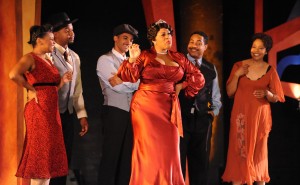 in 1974. Many songs were completed with lyrics by Ellington, but the libretto was entrusted to the unknown Betty McGettigan (d. 2009), who became an intimate friend of the Duke in 1969 and was with him when he died. Since then, McGettigan and dozens of writers, orchestrators, and directors have had their hand at what perhaps should never have been touched. Since 1986, various versions include a 2008 Oakland Opera Theater production and a 2009 version (which McGettigan called “an absolutely true representation of Ellington’s intentions”) staged and recorded by the Butler Opera Company at the University of Texas, Austin.
in 1974. Many songs were completed with lyrics by Ellington, but the libretto was entrusted to the unknown Betty McGettigan (d. 2009), who became an intimate friend of the Duke in 1969 and was with him when he died. Since then, McGettigan and dozens of writers, orchestrators, and directors have had their hand at what perhaps should never have been touched. Since 1986, various versions include a 2008 Oakland Opera Theater production and a 2009 version (which McGettigan called “an absolutely true representation of Ellington’s intentions”) staged and recorded by the Butler Opera Company at the University of Texas, Austin.
But calling it an opera doesn’t make it an opera, which by definition is an extended dramatic composition in which all parts are sung to instrumental accompaniment. Still, nomenclature isn’t the issue here.
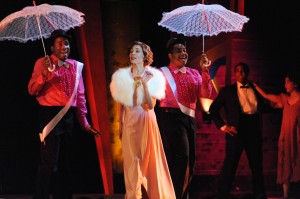 Even with director/choreographer Ken Roht’s near train wreck of a production, it is apparent why producers won’t leave poor Queenie alone. Front and center is Ellington’s music, which is richer and more original than most theater compositions of the last 25 years. One of the greatest composers America has produced, his enormous talent, sophistication and elegance are on full display. Although nothing in this non-opera would qualify as a pop standard, he creates shattering harmonies, jumpy, intense rhythms, and some lovely ballads. The score is whimsically and colorfully flavored with the blues, jazzy Asian riffs, Big Band swing, and more.
Even with director/choreographer Ken Roht’s near train wreck of a production, it is apparent why producers won’t leave poor Queenie alone. Front and center is Ellington’s music, which is richer and more original than most theater compositions of the last 25 years. One of the greatest composers America has produced, his enormous talent, sophistication and elegance are on full display. Although nothing in this non-opera would qualify as a pop standard, he creates shattering harmonies, jumpy, intense rhythms, and some lovely ballads. The score is whimsically and colorfully flavored with the blues, jazzy Asian riffs, Big Band swing, and more.
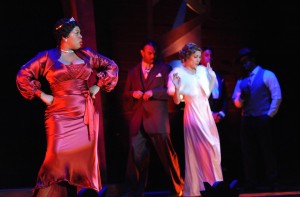 Ellington was a genius at taking elements of folk music and turning them into compositions which sound completely spontaneous, but there are limitations to this style of composing for the theater, as he discovered in his tuneless Broadway flops Beggar’s Holiday (1946, lyrics by John Latouche) and Pousse-Café (1966, lyrics by Once Upon a Mattress’s Marshall Barer). It’s telling that his one Broadway hit, Sophisticated Ladies (1981), is a compilation of 35 stand-alone songs written in part or entirely by Edward Kennedy Ellington himself.
Ellington was a genius at taking elements of folk music and turning them into compositions which sound completely spontaneous, but there are limitations to this style of composing for the theater, as he discovered in his tuneless Broadway flops Beggar’s Holiday (1946, lyrics by John Latouche) and Pousse-Café (1966, lyrics by Once Upon a Mattress’s Marshall Barer). It’s telling that his one Broadway hit, Sophisticated Ladies (1981), is a compilation of 35 stand-alone songs written in part or entirely by Edward Kennedy Ellington himself.
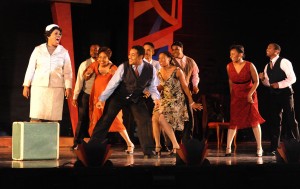 Equally magical at the Warner Grand Theatre was the 16-piece band which perfectly put the cuffs on Marc Bolin and Jeffrey Lindberg’s saturated, opulent, wicked, Big Band arrangements and orchestrations. But neither Lindberg as conductor nor sound designer Bob Christian had an inkling how to balance brassy instrumentations with vocals. The exciting overture filled the theater perfectly, but then the LBO Orchestra drowned out singers, whose mikes were uncooperatively higgledy-piggledy for the entire first act, distorting the chorus and muffling the leads. It’s a damn shame that only the songs were supertitled.
Equally magical at the Warner Grand Theatre was the 16-piece band which perfectly put the cuffs on Marc Bolin and Jeffrey Lindberg’s saturated, opulent, wicked, Big Band arrangements and orchestrations. But neither Lindberg as conductor nor sound designer Bob Christian had an inkling how to balance brassy instrumentations with vocals. The exciting overture filled the theater perfectly, but then the LBO Orchestra drowned out singers, whose mikes were uncooperatively higgledy-piggledy for the entire first act, distorting the chorus and muffling the leads. It’s a damn shame that only the songs were supertitled.
Sound troubles can be fixed, but that libretto (with additional material by Tommy Shepherd and adapted by Roht)? D.O.A. The lack of choral numbers in Act II seemingly helped the sound, but hearing every word of the dialogue only made the plot more indecipherable.
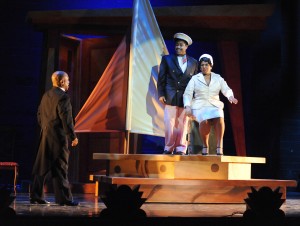 Since 1936, Ellington was inspired to write a musical based on the life of beauty-product entrepreneur Madam C. J. Walker (1867-1919), a Harlem beautician who invented a preparation to straighten hair, and who is cited by the Guinness Book of Records as the first woman to become a self-made millionaire.
Since 1936, Ellington was inspired to write a musical based on the life of beauty-product entrepreneur Madam C. J. Walker (1867-1919), a Harlem beautician who invented a preparation to straighten hair, and who is cited by the Guinness Book of Records as the first woman to become a self-made millionaire.
I detest plot in a review, but the nonsensical goings on are something else: At some sort of surreal Mardi Gras in Harlem, we meet Queenie, a righteous titleholding beautician whose supremacy is endangered by newcomer Café O’Lay, whose rise is attributed to a cream which lightens the shade of black folks’ skin. O’Lay immediately has an affair with Holt Faye, the main beauty title contest judge and Queenie’s lover man (conflicts of interest are unexplored here). The jealous O’Lay murders Faye and goes to prison.
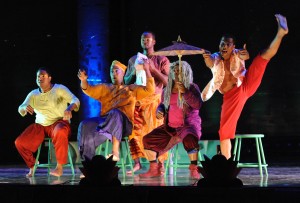 Queenie Pie, at the suggestion of her butler Lil’ Daddy, sails to an enigmatic island inhabited by Chitlin’ Circuit natives and a Witch Doctor (played by the butler with a mop on his head). She seeks some kind of magic flower for “everlasting anythingness,” and beds the island’s impotent King (played by the dead Faye with his shirt off). Meanwhile, the unlikeable O’Lay, who we know nothing about, has a gorgeous love song while working in the pen (the song’s placement exemplifies the show’s consistent senselessness). Anyway, O’Lay mysteriously gets out of jail, the butler sends her to the same island, and Queenie and O’Lay become BFFs.
Queenie Pie, at the suggestion of her butler Lil’ Daddy, sails to an enigmatic island inhabited by Chitlin’ Circuit natives and a Witch Doctor (played by the butler with a mop on his head). She seeks some kind of magic flower for “everlasting anythingness,” and beds the island’s impotent King (played by the dead Faye with his shirt off). Meanwhile, the unlikeable O’Lay, who we know nothing about, has a gorgeous love song while working in the pen (the song’s placement exemplifies the show’s consistent senselessness). Anyway, O’Lay mysteriously gets out of jail, the butler sends her to the same island, and Queenie and O’Lay become BFFs.
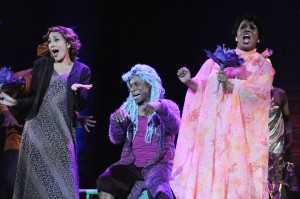 The promising elements—class in America, racial divides, tragic love story, supernatural healing—actually scream to be musicalized, another reason Queenie won’t die (although this production may put the nail in the coffin). But the highly allegorical libretto hovers around the inane, character development is largely ignored, and the lyrics go from repetitive to imprecise to clever; my favorite lyrics came without words as Queenie scatted while on the phone. How I wish that this music could be recorded without the words!
The promising elements—class in America, racial divides, tragic love story, supernatural healing—actually scream to be musicalized, another reason Queenie won’t die (although this production may put the nail in the coffin). But the highly allegorical libretto hovers around the inane, character development is largely ignored, and the lyrics go from repetitive to imprecise to clever; my favorite lyrics came without words as Queenie scatted while on the phone. How I wish that this music could be recorded without the words!
Tossed into the Harlem hijinks and jungle nonsense are commercial jingles which Ellington wrote for the never-to-be-televised score; the poor audience couldn’t figure out when to applaud, and some of the short ditties were followed by stone-cold silence.
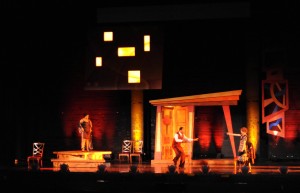 In the attempt to make a contemporary piece timeless, Danila Korogodsky’s nonrepresentational set pieces suggest an Art Deco / East Asian mash-up. Dabney Ross Jones’ 30’s Harlem costumes are sweet, but the rest look like a high school production of Once on This Island. Brandon Baruch’s lights are sumptuous with blacklight blues, deep oranges, and creamy reds. Roht’s direction is quite busy, which doesn’t help us focus on the story (or lack thereof), but his choreography is delightful with truckin’, swinging, skips, and jazz hands.
In the attempt to make a contemporary piece timeless, Danila Korogodsky’s nonrepresentational set pieces suggest an Art Deco / East Asian mash-up. Dabney Ross Jones’ 30’s Harlem costumes are sweet, but the rest look like a high school production of Once on This Island. Brandon Baruch’s lights are sumptuous with blacklight blues, deep oranges, and creamy reds. Roht’s direction is quite busy, which doesn’t help us focus on the story (or lack thereof), but his choreography is delightful with truckin’, swinging, skips, and jazz hands.
Unfortunately, he allows exaggerated characterizations, which creates confusion as to whether the majority of his cast can actually act or not. As with the opera itself, the singing, dancing, and acting is all over the map. And when poor Jeffrey Polk, who is strange as the butler but nothing more than over-the-top weird as the Witch Doctor, is assigned to ask the house how 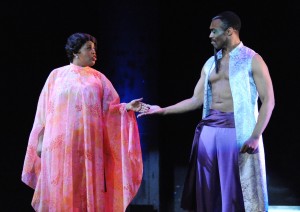 we’re doing early in the show, the tepid response embarrassed me.
we’re doing early in the show, the tepid response embarrassed me.
While Queenie Pie isn’t the mind-boggling flop in the vein of Carrie on Broadway, it came close on opening night (especially when an alarm went off halfway through Act I as if to give the show a hint). I appreciate any musical that travels its own road, but this one never arrives at any destination. Roht is on the right track with his ideas, but it’s unlikely the ludicrous show can be retooled before it hits Chicago two weeks after it closes here. But the creators may find their magic flower: Quick fixes have happened before with out-of-town tryouts, including Sophisticated Ladies.
photos by Keith Ian Polakoff
Queenie Pie
Long Beach Opera
a co-production with Chicago Opera Theater
Warner Grand Theatre, 478 W. 6th St. in San Pedro
scheduled to end on February 2, 2014
for tickets, call 562.432.5934 or at http://www.LongBeachOpera.org
plays in Chicago February 15 – March 5, 2014
with the Chicago Jazz Orchestra
Harris Theater in Millennium Park
for tickets, call 312.704.8414 or visit www.chicagooperatheater.org
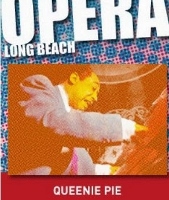
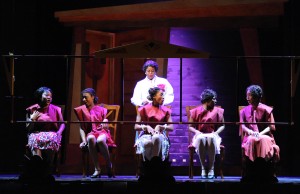

{ 1 comment… read it below or add one }
To the reviewer of “Queenie Pie” in Long Beach, “hog wash.” I have just seen the show in Chicago, and it was terrific. As opera lovers and long-time subscribers to Lyric Opera and Chicago Opera Theater, we know something about opera. We also attend many other musical events in Chicago and around the country. There were no technical foul-ups in Chicago, and our Chicago Jazz Orchestra was excellent. They were already experienced players of the original Duke Ellington music. In a commentary made by the cast, which was the same as that in Long Beach, it was noted that the cast took a lot of time in Chicago to explore the characters in more depth. Maybe that was missing in Long Beach. The premise of the story, the rivalry between cosmeticians, as well as color differences, was a familiar one. Maybe you should come to Chicago and see it again — Joan and Charles Staples